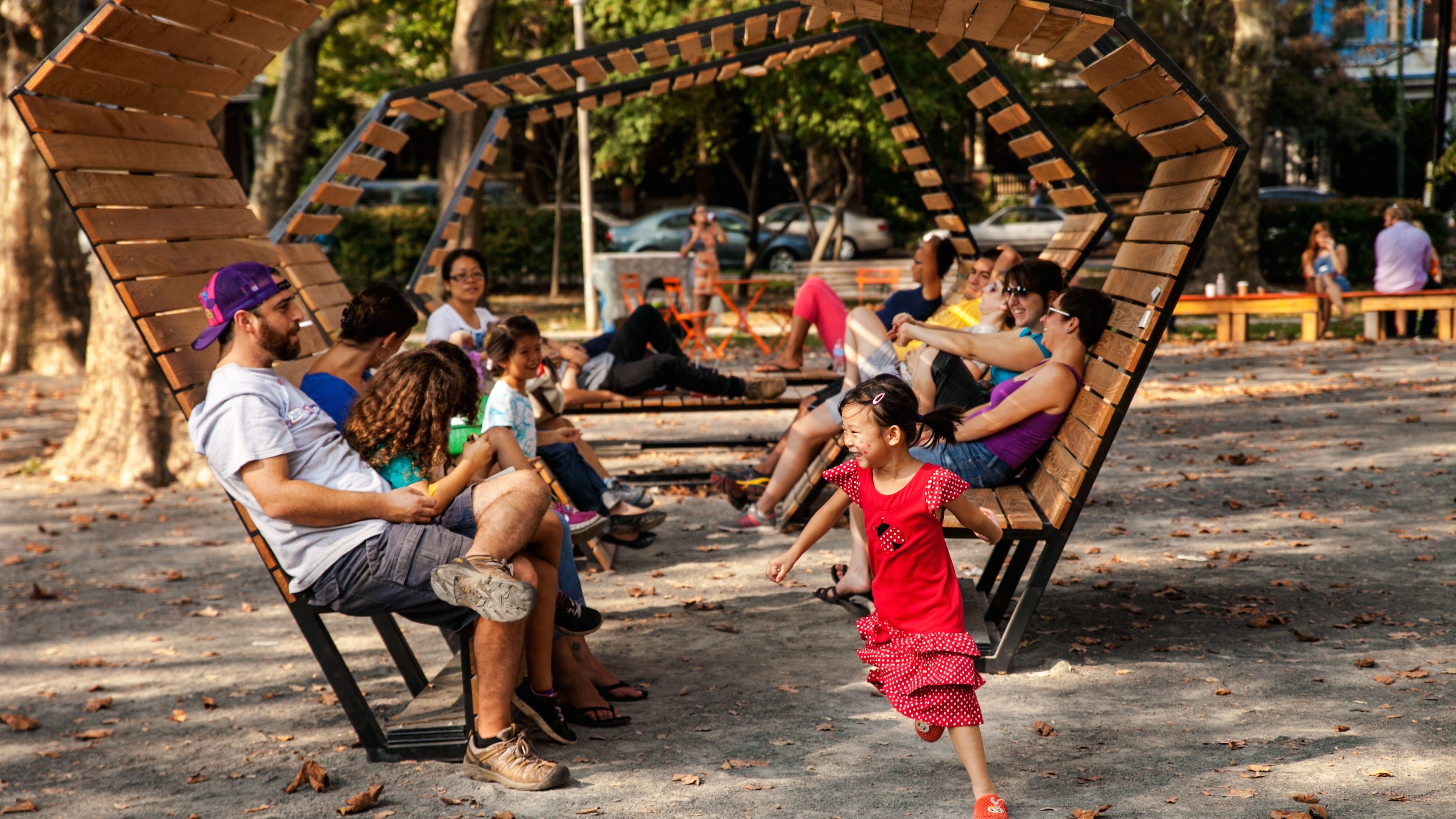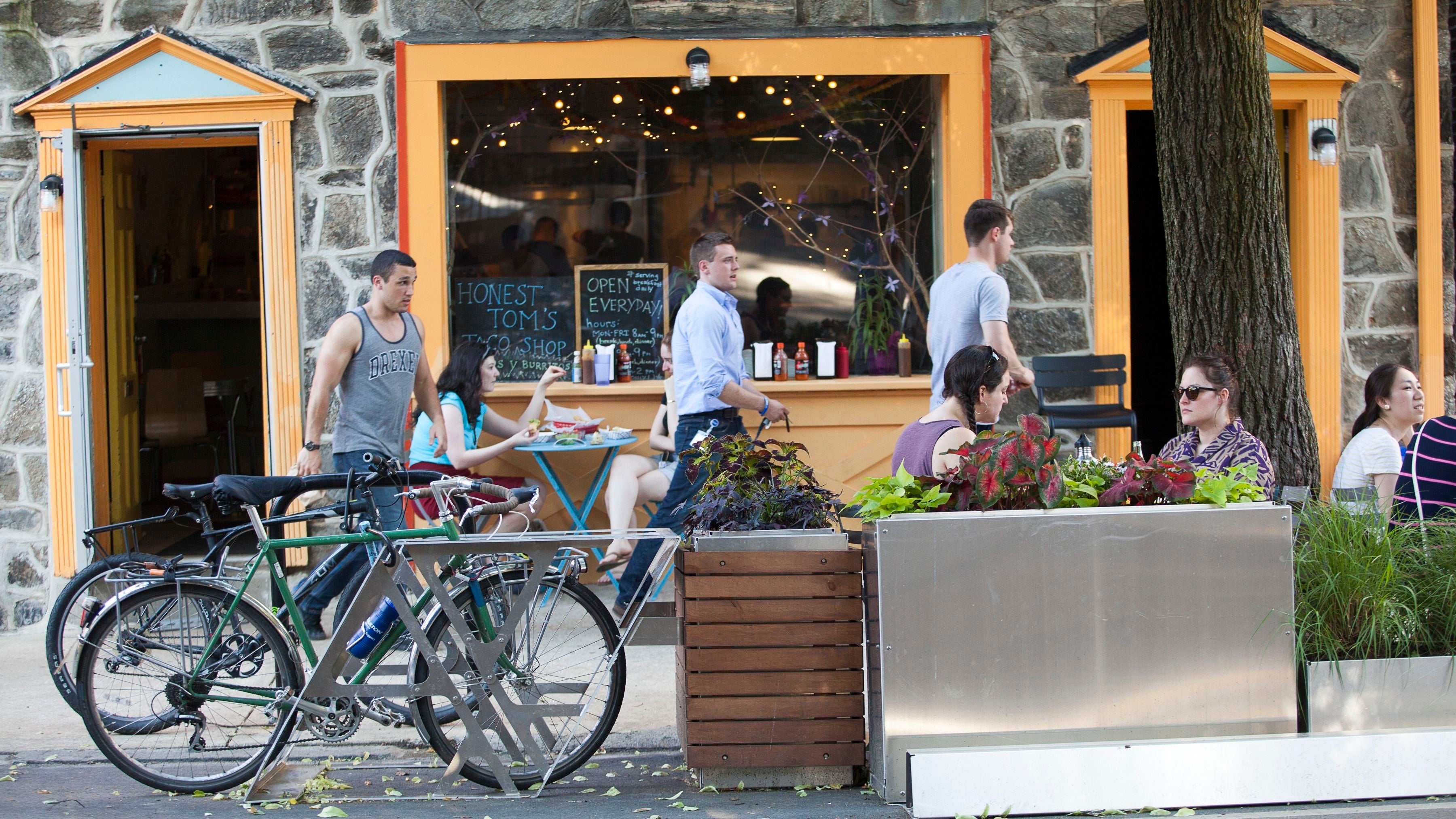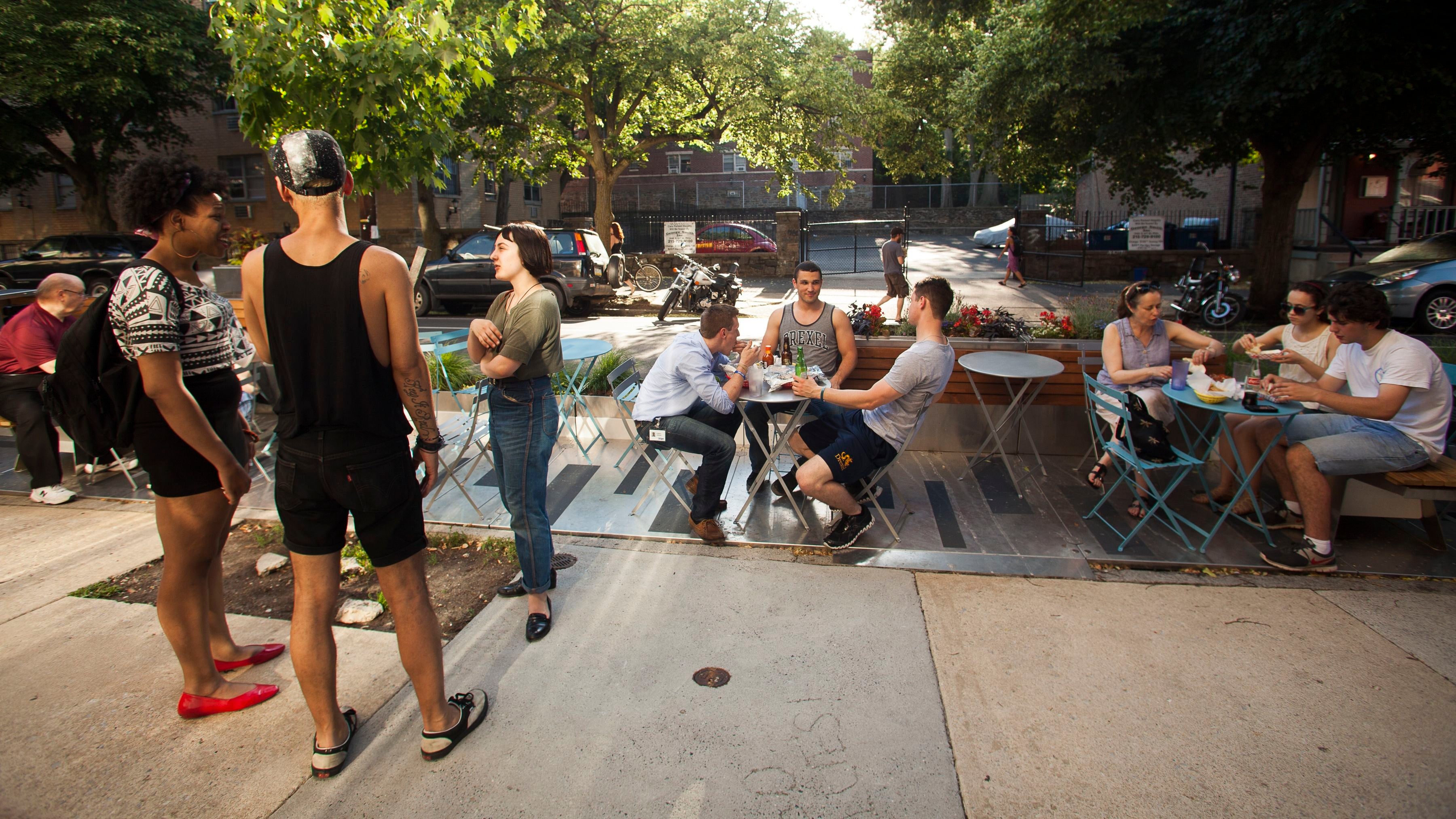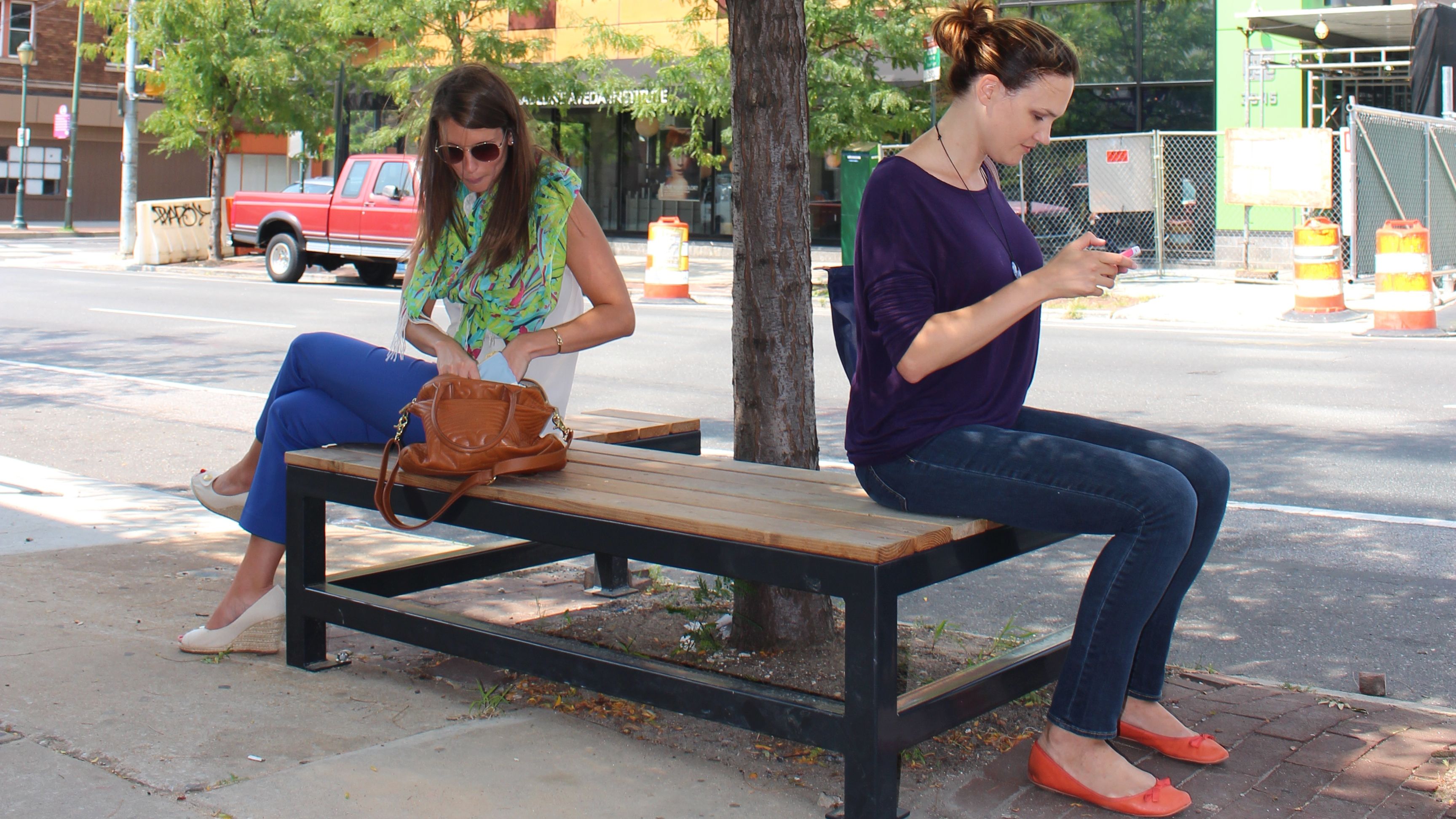University City District is giving city-dwellers somewhere to sit

People sit (and play) in a "Looped In" bench at Clark Park in Philadelphia. (University City District)
At Keystone Crossroads, we’ve been reporting on various forms of tactical urbanism: low-cost, temporary projects intended to create long-term change in a particular public space.
At Keystone Crossroads, we’ve been reporting on various forms of tactical urbanism: low-cost, temporary projects intended to create long-term change in a particular public space.
These projects vary widely. Some focus on attracting people to a specific area. For example, the Delaware River Waterfront Corporation is using temporary, seasonal parks such as Spruce Street Harbor Park in Philadelphia to attract people — and developers — to the water.
Some tactical urbanism projects are about safety. That might mean putting out cones to extend a sidewalk or spray painting crosswalks under cover of night. The ultimate goal is to spur the government to make permanent changes to the city’s streets.
In West Philadelphia, there’s a group doing tactical urbanism projects centered around a seemingly simple idea: providing seating in public spaces. The goal is to increase the quality of life in the area in the long term.
Indeed, that’s the overall mission of University City District, “a nonprofit, neighborhood-based 501(c)3 special services district [that operates in] the 2.4 square mile area” known as University City, Nate Hommel, UCD’s capital projects manager, wrote in an email. The district’s programs and services are funded by donations from University City businesses, institutions, and individuals, as well as grants, sponsorships, and fee-for-service contracts.
Hommel says seating can improve quality of life in a few ways. For one, seats can bolster nearby businesses. They can also activate underutilized public spaces, compelling passersby to stop and interact with each other.
Seating can also make an area more walkable, especially for the elderly, who might need a place to rest in the middle of a jaunt, Hommel says.
Here are a few of the projects the district has installed:
Parklets

People eat in front of a parklet outside Tom’s Taco Shop in Philadelphia. (University City District)
UCD defines these as “temporary seating platforms, placed flush with the curb, [that create] an extension of the sidewalk by replacing one or two parking spaces with a small park.” The district is about to install its sixth parklet and recently released a report analyzing the success of these projects. It found a 20 percent average increase in sales for restaurants that had parklets in front, in the weeks following installation.
The report also found that eating, drinking, and talking to other people were the most common behavior in parklets. Reading and writing were rare. About 20–30 percent of parklet users were not patrons of nearby restaurants. In its report, UCD wrote that the parklets became “magnets for passers-by,” whose decision to stop and chat added “to the palpable buzz of activity” on the sidewalk.

People chat and eat in a parklet on 44th street in West Philadelphia. (University City District)
Many of the parklets filled every seat at peak hours, suggesting that strangers were sitting next to each other.
Indeed, one of UCD’s goals is to get strangers to share space. That doesn’t always happen in public areas, especially when chairs are distributed among smaller tables. So UCD designers created something called “Looped In,” wrap-around benches that are designed to make strangers more comfortable sitting next to each other, especially in a tight space.

People chatting (and playing) on Looped In benches at Clark Park in Philadelphia. (University City District)
The benches, as UCD describes, “appear to loop around on themselves with wooden benches below and canopy-like structures overhead.” The district has installed them at the University of Pennsylvania campus, as well as at Drexel Park, Clark Park, The Porch at 30th Street train station, and other locations.
Tree seats
UCD has also installed seats that wrap around trees on all sides. They were designed so that, ideally, at least one side of the seat would be in the shade at all times. The seats also have a foot rest so that children can sit next to adults “and rest their feet as if they were grown up[s],” Hommel wrote in an email.

Women sit on a “tree seat” in Philadelphia. (University City District)
And the seats have minimal impact on trees, as they are secured to the sidewalk with small anchors.
Community resistance
Hommel says these projects, simple as they may seem, have stoked fear in some residents.
Those residents are concerned about raucous behavior overnight, and people sleeping on the benches. To some residents, those concerns include attracting people who are homeless. UCD, for its part, feels that “anybody who behaves well is welcome to use our public spaces,” Hommel said.
But to allay residents’ fears, UCD created some parklets that have removable tables and chairs. The parklet hosts, often nearby businesses, pull in the tables and chairs at night and bring them out in the morning.
The district has also installed parklets with permanent seating, and Hommel hasn’t heard of any problems from residents.
The temporary, low-cost nature of these projects makes them easier for residents to swallow. The district makes it clear that if the seats are causing problems, they can be moved.
Providing that assurance allows UCD to get its point across, that “there’s more good that can come from a seat than bad,” Hommel said.
Long-term goals
Hommel says UCD would like to see some of its successful parklets become permanent. But perhaps more important, he says, these seating projects teach the organization about how people use public spaces.
For instance, “how important is shade?” he said. “How much do people fear cars being next to them? How long do they stay?”
UCD is currently designing a trolley portal at 40th street. The district is incorporating lessons it learned from its other tactical urbanism projects, includes the “social seating” benches.
In that sense, these iterative projects are “a way to make smart decisions that help lead to a bigger project,” Hommel said. “Our hope is that we are constantly learning, and using these early interventions to make the city a nicer place to be.”
WHYY is your source for fact-based, in-depth journalism and information. As a nonprofit organization, we rely on financial support from readers like you. Please give today.


